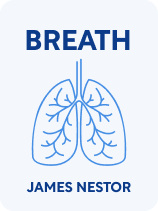

This article is an excerpt from the Shortform book guide to "Breath" by James Nestor. Shortform has the world's best summaries and analyses of books you should be reading.
Like this article? Sign up for a free trial here.
What is James Nestor’s Breath about? What is the key message to take away from the book?
In Breath, James Nestor argues that while the power of the breath is central to many Eastern traditions, it’s been largely ignored in the Western world. Modern medicine puts little emphasis on teaching people how to breathe correctly. However, Nestor asserts that by learning how to breathe well, we’ll improve our well-being, balance our emotions, and find more energy to live the lives we want.
Below is a brief overview of Breath: The New Science of a Lost Art by James Nestor.
Breath: The New Science of a Lost Art
As we try to lead healthier lives, we often focus on eating better, getting more exercise, and tending to our mental well-being. One vital aspect we rarely even think of is how well we breathe. Modern medicine treats breathing problems with medications and surgical options, but little attention is ever given to teaching people how to breathe well. In fact, how we breathe has just as much bearing on our quality of life as any other factor.
(Shortform note: The physical act of breathing plays multiple roles in the body. The most basic, of course, is that it provides our cells with oxygen, the most vital component to unlocking our body’s energy. Beyond that, breathing regulates the nervous system and can be used to reduce overall stress. The American Lung Association recommends some basic exercises to improve how you breathe. We’ll cover several more in this guide.)
Today, a staggering number of people suffer from chronic congestion, infections, weakness in the lungs, and health conditions caused by an inability to properly breathe. Advances brought about by the evolution of our brains and how we live in the industrialized world have had a negative impact on the muscles, bones, and tissues responsible for bringing air into our bodies. And yet, James Nestor argues that we can reverse the trend by relearning proper breathing techniques. We can increase blood flow, stretch our lungs, open our airways, and even balance our moods for longer, healthier, more energetic lives.
Nestor is a science journalist who was introduced to the power of breath when researching freedivers for his previous book, Deep. The divers he interviewed had trained their bodies to go without air for over 10 minutes by taking conscious control of how they breathe. This, coupled with Nestor’s personal history of breathing problems, sparked his interest in the science of breath and led to him uncovering the stories of those who had researched this aspect of life.
(Shortform note: Since the 2014 publication of Deep, the abilities of freedivers to go without breathing have stretched even further. As of 2021, the world record for breath-holding was 24 minutes, 37 seconds, set by Croatian diver Budimer Šobat. Divers are able to stretch their breath by using oxygen to purge their bodies’ carbon dioxide while taking advantage of the fact that submerging in cold water slows the body’s metabolism.)
In Breath, James Nestor recounts his personal journey and those of others who’ve studied how breathing affects the body and mind. In this guide, we’ll distill the principles he reveals about why we breathe poorly in the modern world, how we can learn to restore healthy breathing, and what extreme breathing techniques can teach about how the breath, mind, and body interact.
Many of the discoveries Nestor describes were made outside traditional medicine and science, and some tie into spiritual traditions practiced for thousands of years. Therefore, in this guide, we’ll also examine what empirical research says about Nestor’s claims and how experts on meditation and yoga approach the practice of breathing, and we’ll explore additional breathing techniques to the ones Nestor recommends.
Breathing Poorly
Before we can discuss how to breathe correctly, it’s important to understand how we’re doing it wrong. Nestor asserts that through no fault of our own, the advances we’ve made biologically and technologically over the past two million years have caused the human race to develop the most poorly designed breathing organs in the animal kingdom. The breathing problems experienced by millions of people today can be traced to how our sinuses and throats evolved over the ages, resulting in a tendency to breathe with our mouths and take in too much oxygen at once, throwing our body’s systems into imbalance.
(Shortform note: The Global Burden of Disease Study in 2017 showed that 550 million people suffer from some form of chronic breathing problem. In the US in 2016, breathing problems resulted in 85 million medical visits. One contributing factor that Nestor doesn’t mention is damage caused by smoking, which accounts for 90% of lung cancer deaths and 80% of deaths from chronic obstructive pulmonary disease.)
According to Nestor, modern medicine rarely considers the importance of the nose and the sinus cavity, shrugging off conditions such as chronic congestion as a norm for everyday existence. Pulmonologists focus on problems of the lungs without taking into account the passages and organs responsible for delivering air to them. Rhinologists treat sinus problems with medications and surgeries without addressing the underlying causes.
(Shortform note: Specialization can lead to doctors shoehorning people’s medical needs into their particular area of focus without taking the body’s bigger picture into consideration. The medical community itself has come to acknowledge the shortcomings inherent in specialization. In particular, people with multiple conditions receive subpar treatment when specialists fail to consider how the treatment of one issue interacts with others. A report in 2003 cited 44,000 annual deaths due to medical errors, many of which may have been caused by specialization.)
In this section, we’ll examine why our bodies are poorly adapted to breathing, and the two main ways that most of us breathe incorrectly—breathing with our mouths and taking in too much air at once.
Our Ancestors’ Legacy
The roots of our modern breathing problems began a long time ago. The evolutionary development of the human brain, as well as some of the uses we’ve put our brains to, have had a detrimental effect on the mouth, nose, and sinus cavity. This devolution was triggered when we learned to cook and speak, and accelerated once we learned to farm, leading to a cycle of softer food production that went hand in hand with the weakening of the human face.
Nestor writes that about 1.5 million years ago, the precursors of homo sapiens learned to tenderize food and later to cook it with fire. Both of these advancements allowed our forebears to make use of more calories from the food they ate. All that additional energy provided for the evolution of larger human brains, which improved our ability to outthink prey and find the best shelter. However, bigger brains came at a cost—they slowly crowded out the sinus and pushed our noses farther out of our skulls. Narrower noses evolved in colder climates to more efficiently heat the air that we breathe.
(Shortform note: The evolution of the brain and the skull is a little more complex than Nestor suggests. In fact, the human brain has decreased in size over the last 90,000 years. What’s changed most is the skull’s overall shape, transitioning from an oblong structure to the rounded modern human head. This has had the effect of repositioning the face under the brain instead of in front. Anthropologists suggest that the changes are related to the development of our temporal lobes.)
The other evolutionary advance that restructured how we breathe was the development of language. Speech was a game-changer for the human race in that it allowed us to pass information from person to person and generation to generation. Nestor explains that as we grew the need for ever more complex vocalizations, evolutionary selection reshaped our speech apparatus. Our lips shrank and the larynx descended deep into the throat to accommodate a wider array of sound. This greatly increased our ability to communicate, but it came with a negative side effect—a larynx so deep that it’s susceptible to choking. Nestor says that humans are in fact the only mammals capable of choking to death on our food.
(Shortform note: The claim that only humans choke on food is not entirely accurate—horses can choke on food that isn’t chewed, and dogs can suffer a similar problem, though the frequency and mortality of choking in humans are particularly high. Humans also differ from other mammals in that we can’t swallow and breathe at the same time. While it’s been believed that infants breathe and swallow simultaneously up to the age of 3 months, recent findings dispute this.)
But it’s not just our sinuses and throats that are the problem. Anthropologists studying human skulls have connected the rise of crooked teeth in humans to about the same time as the invention of farming, but even as recently as a few hundred years ago, our ancestors still had stronger jaws, straighter teeth, and wider airways than we do today. Nestor writes that the rate of dental problems have skyrocketed in the last 300 years, along with humans having a higher prevalence of small chins, weak jaws, and difficulties breathing.
The culprit is almost certainly the advent of processed food brought about by industrialization. Sugar became a more prominent part of our diet, while fiber and minerals declined. People in urban areas in particular can go their whole lives without eating anything that exercises the jaw, with bone loss and muscle atrophy occurring as a direct result.
When we’re raised from childhood on a diet of soft foods, Nestor argues that our mouths never fully develop and our facial bones grow weaker. He points to the earliest orthodontic devices, which were originally designed to enlarge the mouth. Later dental practices switched to pulling teeth in order to make room for others, which had the side effect of shrinking the mouth while making it easier for dentists to manage. While doing so may give us straighter teeth again, small mouths and bone loss lead to sleep apnea, snoring, and a host of diseases related to obstructed airways.
(Shortform note: While recognizing the link between weakening faces and our health, some doctors see nasal congestion as a cause of small mouths, and not merely a result. Beyond the physiological reasons, some scientists theorize that our facial structure changed because of our need to express a broad array of emotions.)
How We’re Breathing Wrong
Even though the average modern mouth is poorly shaped for airflow, chronic nasal congestion has trained many of us to use our mouths as our primary source of air. Breathing through the mouth, though, is highly inefficient and creates even more difficulties for the body. To explore the problems caused by mouth breathing, Nestor himself volunteered for an experiment that would demonstrate the effects of poor breathing on the body, such as fatigue, cognitive impairment, sleep deprivation, and high blood pressure.
(Shortform note: Nestor admits there’s a lack of firm statistical data as to how many people breathe with their mouths instead of their noses. He cites a study of Brazilian children that found that 55% were mouthbreathers, with a correspondingly higher number of health problems. In the US, a survey by the maker of Breathe RightⓇ nasal strips showed that 61% of participants self-identify as mouthbreathers.)
The experiment was simple. Nestor simulated total congestion by plugging both of his nostrils for two weeks while monitoring his vitals on a regular schedule. After several days, his blood pressure had increased to the first stage of hypertension, his pulse had gone up, and his body temperature dropped. By the end of the two weeks, his snoring at night had increased by a staggering 4,000%, while his oxygen levels had dropped below 90% (which, if maintained, deprives the body’s organs of oxygen). Mentally, the author was a wreck—he found it very difficult to focus while awake and nearly impossible to get any sleep at night.
(Shortform note: The study Nestor participated in was conducted by Jayakar Nayak of Stanford University, a doctor who is an expert in treating major sinus disorders. Nayak has researched tumors in the larynx, the effects of empty nose syndrome, and has looked into the relation between nasal obstruction and the shape of the palate. As of the time of Nestor’s writing, the results of Nayak’s study have yet to be published.)
By blocking his nostrils, Nestor highlighted the two major ills of the way we often breathe: relying on our mouths and taking in too much air.
Mouthbreathing
Nestor claims that mouthbreathing isn’t ideal because the mouth is meant to serve as a backup air pathway—it lets us take in lots of air quickly, but it lacks the tissues the sinus cavity uses to filter the air and move it along. Breathing through your mouth also consumes more energy, leading to bodily stress and fatigue. This stress pushes your heart to beat faster while your muscles rely more and more on anaerobic energy, another of the body’s backup systems, burning sugars and building up lactic acid. This leads to nausea, muscle weakness, and sweating.
This can be clearly demonstrated during exercise. Nestor explains that when you start working out, your muscles tap into anaerobic energy as your respiratory system tries to catch up. Anaerobic power from breaking down sugars is a turbo boost that evolution designed to kick in along with our fight-or-flight response. However, anaerobic respiration isn’t meant to be sustained for long periods, as it is when you consistently breathe through your mouth.
Aerobic respiration—taking energy from oxygen—is ideal for exercise, yet the more you pant and gulp to catch air, the more your heart races and the longer your body stays in the anaerobic zone. The solution Nestor gives is to breathe only through your nose and monitor your pulse. For optimal aerobic exercise, your pulse should not exceed 180 minus your age. (For example, if you’re 50, your exercising pulse should be under 130.) Mouthbreathing invariably pushes you over this limit.
(Shortform note: Whether aerobic is preferable to anaerobic exercise isn’t as straightforward as Nestor suggests. In short bursts, anaerobic exercise—such as sprinting or weightlifting—has benefits of its own. Anaerobic training strengthens muscles and increases endurance while forcing the body to burn even more calories while replenishing its oxygen content. If your goal is to burn fat, high-intensity anaerobic exercise can be more effective than aerobic exercise.)
Overbreathing
Another issue with our breathing is that we breathe too much. Overbreathing, whether during exercise or the normal course of life, overworks your metabolism and throws off your body’s balance of oxygen and carbon dioxide. Carbon dioxide, argues Nestor, is more than just a gas we expel—it’s a vital part of the chemical exchange that provides oxygen to our organs. Rapid, heavy breathing purges carbon dioxide from our bodies, reducing the distribution of oxygen to our cells. You may take in more oxygen to your lungs, but without the right balance of carbon dioxide in your blood, you’ll simply breathe most of the oxygen right back out.
(Shortform note: The rate of oxygen absorption by the lungs is surprisingly low. We normally breathe in 5-8 liters of air per minute, which contains 1-1.5 liters of oxygen but provides only 0.3 liters of oxygen to the blood, roughly 5% of the volume of air inhaled. As breathing increases during exercise, the rate of oxygen extracted per volume of air drops as low as 3%.)
No one understands this feeling better than people who suffer from asthma. Once you start hyperventilating, no matter how much you breathe, your body knows you’re not getting enough oxygen and desperately reaches for more, to no avail. Nestor points to a study at Southern Methodist University in which people suffering from asthma attacks were trained to take shallow breaths, not deep ones, resulting in a lessening of symptoms.
Because of the importance of the body’s oxygen/carbon dioxide balance, Nestor argues that so-called “oxygen bars” (spas and gym kiosks where you breathe purified oxygen) have no benefit. Any excess oxygen you breathe is immediately exhaled, unprocessed. An extra supply of oxygen is only medically useful at high altitudes and for people who cannot maintain a healthy amount of oxygen saturation in their blood.
(Shortform note: Oxygen bars, which tout the health benefits of breathing high doses of oxygen, rose in popularity in the early 2000s. Oxygen bar proprietors claim that their spas reduce stress while boosting energy and endurance. The American Lung Association disagrees and suggests there may be negative effects from particulates these spas use to scent the air.)
How to Breathe Well
Now that we’ve established how we’re breathing wrong, the question becomes, “How should we breathe?” Luckily, we don’t have to reinvent the wheel. Nestor provides a selection of breathing techniques that have been known and practiced for ages, but not necessarily in Western medicine. However, the science behind them is suggestive of their value. By regulating your breath so that you breathe through your nose, slow your respiration, and use your diaphragm and mouth correctly, you can create a positive feedback loop that will strengthen your sinuses, stretch your lungs, and restore your body’s equilibrium.
(Shortform note: While Nestor is correct to point out that breathing is central to many belief systems and meditative practices, he understates the amount of research that modern medicine has invested in the scientific aspects of breath control. A review of medical literature reveals a wide scope of studies on the mental and physical benefits of controlled breathing.)
Breathe Through Your Nose
The first and most important step Nestor advises is to retrain yourself to use your nose and not your mouth to breathe. Your nose and sinus cavity are specifically designed to process air in ways your mouth can’t. Breathing through your nose strengthens your airways, regulates your metabolism, and even has a positive effect on the brain.
The immediate effect of breathing through your nose is that the tissues in your sinus and the back of your throat cease to atrophy from lack of use. As with muscles, the sinus and throat will grow stronger with exercise; they will soon function better and allow for a healthier airflow. Meanwhile, the nose’s cilia (fine hairs) and turbinates (boney structures) heat and clean the air you inhale so your lungs can extract more oxygen from it. The sinus also releases nitric oxide into the body, which widens blood vessels and increases circulation. In the author’s self-experiment, when he unplugged his nostrils, in only a few days his blood pressure went down and his blood’s carbon dioxide returned to normal.
(Shortform note: The anatomy of the nose and sinus cavity is even more complex than Nestor’s description indicates. It’s an ornate structure of cartilage, bone, skin, fatty tissue, three pairs of turbinates, and four pairs of sinuses. In addition to the infections and congestion Nestor warns of, it’s also vulnerable to nosebleeds, cancer, injuries, and genetic disorders. While scientists confirm Nestor’s assertion that nitric oxide is crucial to supplying oxygen to the body, it’s still not fully understood how or where it’s produced in the nasal cavity, though current evidence points to the paranasal sinuses, which were long considered to be unimportant organs.)
But it’s not just the act of breathing that does this. Nestor writes that there is a nasal cycle in which the right and left nostril alternate to control body temperature, blood pressure, and brain chemicals. (If you notice from time to time that one nostril congests while the other stays open, and then they mysteriously switch later on, this is the nasal cycle in action.) When breathing through your right nostril, your pulse, blood pressure, body temperature, and cortisol levels increase. Breathing through the left nostril has the opposite effect, and cycling between the two maintains your body’s balance. Breathing through your mouth, on the other hand, disengages the nasal cycle completely, depriving you of its body-regulating benefits.
Furthermore, the nasal cycle helps regulate the brain. The right nostril is connected to the sympathetic nervous system, raising alertness and logical thinking. Likewise, the left nostril is linked to the parasympathetic nervous system, affecting creativity and abstract thought. By switching the breath back and forth between the two, the body maintains mental equilibrium between states of relaxation and alertness.
Slow Your Breath Down
While switching to breathing with our noses may seem simple, the next step will take more concentration and practice. According to Nestor, our optimal breath rate is slow—much slower, in fact, than what we’re used to. To explain why this is, we must understand the vital role that carbon dioxide plays in our body chemistry and how breathing slowly will affect our chemical balance. Beyond that, Nestor asks us to consider the benefits of not only breathing slowly, but breathing less air all at once.
The science we’re taught in school is basically true—we inhale oxygen and exhale carbon dioxide. What’s false, says Nestor, is the implication that carbon dioxide is merely a waste product, when in fact it’s a vital part of the chemical exchange that gives the oxygen in our blood access to our organs. As our muscles and organs do more work, they burn energy and create carbon dioxide, which releases oxygen from the hemoglobin in our blood cells. As stated earlier, heavy breathing purges carbon dioxide from the body, which short-circuits the necessary chemical exchange and starves our cells of the very oxygen they need.
Nestor writes that breathing more slowly doesn’t lower the amount of oxygen in the body, but it does increase the amount of carbon dioxide, allowing more of the oxygen to be absorbed. When we breathe “normally,” we only absorb about 25% of the oxygen we take in. On the other hand, slow breathing lets us absorb more oxygen using fewer breaths—a more efficient process for the whole body that uses less work to produce more energy. Oxygen flow to the brain increases, and all our other bodily functions align themselves to work at top efficiency.
(Shortform note: This claim of Nestor’s may be overstated. Research has shown that slow, controlled breathing increases oxygen saturation levels in people with conditions such as chronic heart failure, but others argue that it has no such effect on otherwise healthy people. However, studies confirm that slow breathing increases blood oxygenation for people at high elevations. To what extent this applies at lower altitudes is unclear.)
The idea of breathing more slowly isn’t new. Spiritual practices from all around the world have ritualized slow breathing in the form of meditations, chants, and prayers. Nestor points out that all these disparate traditions, whether Tibetan or Catholic or Native American, have settled on approximately the same ideal breath rate: 5.5 seconds to breathe in, 5.5 seconds to breathe out. This, it seems, is the ideal rate of breath to bring the body and mind into alignment.
(Shortform note: Different breathing practices and their associated benefits vary more than Nestor suggests, though they’re in the same ballpark. Research on long-time yoga practitioners found that they pace their breathing at 3-4 breaths per minute, slower than Nestor’s ideal rate. Studies on heart rate variability, an indicator of cardiovascular health, show that it peaks at a rate of 8 breaths per minute, 50% faster than Nestor recommends. In the relaxation technique called box breathing, you inhale for 4 seconds, hold your breath for 4 seconds, exhale for 4 seconds, and pause for 4 seconds, for a total of 5 breaths per minute.)
Hypoventilation
Some researchers believe that breathing less air can increase the body’s overall performance. Known as “hypoventilation training,” this involves limiting your inhalations during exercise while extending the time you take to exhale. This accustoms the body to higher carbon dioxide levels and trains you to take in less air while resting. Studies have shown that this practice heightens athletic performance and is beneficial to people who suffer from asthma. Patients undergoing hypoventilation therapy developed higher resting carbon dioxide levels and fewer asthma attacks. Nestor admits that hypoventilation isn’t for everyone, in particular people who have emphysema (and therefore, already high levels of carbon dioxide).
(Shortform note: For more information, Nestor points readers to the Association for Research and Promotion of Hypoventilation Training. A study of hypoventilation in basketball players suggests that it improves the reoxygenation of muscles after bursts of exertion such as sprinting, leading to shorter recovery times. However, studies also show that voluntary hypoventilation leads to muscles deoxygenating faster in sprints than in people breathing normally while performing the same activity.)
He also states that no one’s really sure why hypoventilation training works. The leading theory is that it affects the body’s pH level (the body functions best at pH 7.4). Our “normal” practice of overbreathing makes the blood more alkaline, and other organs such as the kidneys have to release chemicals into the blood to compensate, which over time depletes the body’s minerals. Breathing less air, then, resets our pH without putting extra stress on the body’s resources.
(Shortform note: There are many factors besides overbreathing that can alter the body’s pH. Obesity, lung and heart problems, aspirin, and opiates can all make the blood more acidic, while dehydration, vomiting, diuretics, and antacids can make the blood more alkaline. Doctors treat pH imbalances with a variety of medications and therapies, depending on the specific condition, but you can also maintain your pH balance by eating right and drinking enough water.)
Strengthen Your Diaphragm and Mouth
Now that we’ve examined the benefits of breathing through your nose and slowing your breath, we’ll discuss how to strengthen your body’s breathing apparatus. Nestor focuses on two particular areas: the diaphragm muscle that drives your breathing and the muscles and bones of the face that support your vital airways. Training the diaphragm to work harder has been shown to help both patients with breathing problems and Olympic athletes, while strengthening the muscles of the face can help anyone undo the damage of a life of soft foods.
(Shortform note: Since the diaphragm doesn’t press against the skin, it’s a muscle many people aren’t even aware of. As the horizontal muscle attached to the base of the ribcage, the diaphragm separates the chest from the upper abdomen. In addition to pumping the respiratory system, it regulates the pressure that pushes matter through the gastrointestinal tract. The diaphragm is divided into three major sections—sternal, costal, and lumbar—and has several openings for blood and other fluids to pass from upper to the lower part of the body.)
Strengthening the diaphragm has long been the province of vocal coaches, in particular choir director Carl Stough, whose success training singers to improve their lung capacity led him to join forces with doctors treating people with tuberculosis. By training the patients to better use their diaphragms, they were able to regain more use of their lungs and improve their quality of life. Driven by the diaphragm, the pressure of our lungs breathing in and out creates a process called the thoracic pump, which brings blood back to the heart to replenish it with oxygen. Stough went on to bring his diaphragm-strengthening techniques to athletic training, enabling several Olympians to break their personal records in the 1968 games.
(Shortform note: Diaphragm breathing has long been a staple of musical training for vocalists and is also key to meditation because of how effectively it reduces feelings of stress. Long after Carl Stough’s work in the 1960s, studies have shown that diaphragm breathing during exercise reduces the imbalance between free radicals and antioxidants (oxidative stress) caused by exhaustive workouts. For athletes, it’s been suggested that diaphragm breathing improves coordination, reaction time, and the ability to process new information.)
In order to maximize the benefit of diaphragm training, it’s vital to open your airways. Nestor says that to do this, you should learn to maintain good oral posture, holding your mouth closed with your teeth gently touching and your tongue against the roof of your mouth. This positions your face to maximize the airways that allow you to breathe through your nose.
(Shortform note: In Breath’s appendix, Nestor directs readers to Andrew Weil’s 4-7-8 Breath Technique that combines diaphragmatic breathing with proper positioning of the teeth and tongue. Physiologists add that holding your tongue at the roof of your mouth increases the stability of your head, neck, and spine.)
Oral posture is hard to maintain if your face is out of shape from a lifetime of soft foods, but it can be toned and strengthened like any other part of your body. Nestor explains that the maxilla (the primary facial bone) is more malleable than any other in the body—it can grow and reshape itself all our lives. It does this via stem cells in the seams between the bones in your skull, cells that are activated by the act of chewing. Therefore, eating hard, unprocessed foods promotes increased bone mass in your face and strengthens the muscles that hold your airways open. You can also increase bone mass by using an oral appliance designed to widen the mouth.
Extreme Breathing Techniques
While researching the intricacies of how breathing works and how we can train ourselves to do it better, Nestor came across many unusual breathing practices and techniques. He doesn’t explicitly recommend readers try them, certainly not without expert supervision, but he presents them as examples of the power of the breath to affect the body and mind.
From Tibetan monks to athletes and psychologists, there are those who have found ways to use controlled breathing to alter mental states and perform seemingly miraculous feats of physical endurance. Nestor writes about several such practices—the art of using the breath to control body temperature, the use of carbon dioxide to reset the brain’s chemoreceptors, and ancient yogic practices that can affect the autonomic systems of the body.
But how is this possible? The simplest explanation is that breathing is the one bodily function in which our conscious and unconscious systems overlap. Just as your heart regulates blood flow, your stomach digests food, and your immune system fights off infection, your respiratory system needs no conscious control. However, unlike our body’s other autonomic systems, we can purposefully alter our breath. The respiratory system is an opening through which we can consciously influence other autonomic functions. In computer terms, the lungs provide an exploit that we can use to control parts of our bodies that we wouldn’t otherwise have access to.
Hacking the Nervous System
To understand how this works, Nestor explains how the lungs interact with two different parts of the autonomic nervous system. Different nerves are connected to different parts of the lungs, so by making your breath shallower or deeper, you can deliberately trigger different responses in your body. Nestor describes what the different triggers do, how Tibetan monks developed this practice to survive in the frigid Himalayan heights, and how Dutch athlete Wim Hof uses the same techniques to perform incredible acts of endurance.
According to Nestor, the autonomic nervous system is actively regulated by breathing. It’s broken into two parts: the parasympathetic nervous system, which triggers rest and relaxation, and the sympathetic nervous system, which gears our bodies up for action. The parasympathetic nervous system is connected to the lower parts of our lungs, which is why slow, deep breaths are calming. Conversely, the sympathetic nervous system is tied to the lungs’ upper regions. Short, rapid breaths that only reach the top of the lungs trigger the sympathetic nerves into action, putting your body into a heightened state of stress. Evolution designed that heightened state for our survival, but the body isn’t meant to stay in it for long.
Nestor writes that a breathing technique known as Tummo (or “inner fire”) was developed in Tibet 1,000 years ago. The practice involves taking a series of breaths into the lower lungs, releasing them with a wavelike motion from the abdomen. After exhaling the final breath, you hold it for as long as you can, then follow that with an enormous inhalation, which you also hold for as long as you can. Nestor repeats that this shouldn’t be attempted without supervision or by anyone with a heart condition.
Tummo activates the sympathetic nervous system and allows a practitioner to remain in that state for extended periods of time. Doing so keeps the body warm, allowing Buddhist monks to weather the extremes of high-altitude cold. Because this technique goes against the body’s natural cycles, though, it can be dangerous and its use was restricted to those who had undergone rigorous training.
(Shortform note: In his notes, Nestor cites a 2013 study comparing expert Tibetan practitioners of Tummo with a control group of people trained in the Tummo breathing technique but not the meditative component of the practice. The study found that both groups were able to use the breathing technique to raise their body temperature, but those who had mastered the meditative component were able to sustain the higher temperature for a longer duration.)
Slowly this technique has made it to the outside world. Some soldiers, athletes, and martial artists have used versions of it to prime their bodies for periods of extended exertion. Tummo found its ultimate modern expression in the Dutch athlete and motivational speaker Wim Hof, who has demonstrated its power to ward off frostbite, exhaustion, heatstroke, and even infection. Hof has touted his techniques as beneficial, but Nestor points out that to date, no one knows the long-term effects of activating the sympathetic nervous system for long periods.
Resetting Your Fear Response
While bringing air into different parts of your lungs can trigger different responses in your body, you can also affect unconscious responses by exposing yourself to excess carbon dioxide. In particular, the brain’s chemoreceptors, which act as a fear alarm system for the body, can be trained to have a higher carbon dioxide tolerance. Nestor describes how our chemoreceptors work, the benefits of pushing their limits, and how carbon dioxide therapy has been used to treat a myriad of problems.
The primary function of the chemoreceptors found in the central brainstem is to monitor the amount of carbon dioxide in the blood, telling our lungs when to breathe. If they sense that our carbon dioxide levels are too high, they activate a panic response completely independent of the one in our amygdala. It’s the fear of suffocation or drowning, and it can override any other conscious response. For those with sleep apnea, it’s what wakes you up at all hours of the night. The chemoreceptor response can also be tickled throughout the day if prolonged distraction results in shallow breathing (a condition Nestor describes as “email apnea”).
Nestor suggests that if your chemoreceptors can be trained to tolerate higher levels of carbon dioxide, it opens up a range of possibilities. Flexible chemoreceptors let people adapt to high altitudes or dive to the depths of the ocean. Since carbon dioxide in the body promotes oxygen delivery to organs, trained chemoreceptors can extend the usefulness of every single breath. Furthermore, because chemoreceptors are closely tied to our primal fear response, widening their tolerance range can be useful in treating anxiety and other neurological conditions.
Carbon dioxide therapy is a technique developed by physicians in the early 20th century to reset oversensitive chemoreceptors by raising the body’s carbon dioxide levels. Patients were made to breathe a mixture of 70% oxygen and 30% carbon dioxide, which initially provokes a feeling of suffocation even though the body is being supplied with more than enough oxygen to survive. Repeated exposure was found to alleviate symptoms of anxiety and even wake patients out of catatonic states. Nestor writes that by the 1950s, doctors switched to medication as their primary form of treatment, though research on carbon dioxide therapy resumed in the 1980s.
The Breath of Life
As scientists and physicians work to better understand the ways that breath regulates our body’s functions, practitioners of several ancient traditions have used breath to master the body for thousands of years. In many cultures, breath is believed to be the energy of life, an energy that can be manipulated to spectacular effect. Nestor briefly outlines the nature of these beliefs and cites the example of Swami Rama, whose amazing, breath-induced control of his body was documented by scientists in a 1970 study.
Sages and healers in India and China identified breath—known as prana to students of yoga—as the energy of life as many as 3,000 years ago. The practices of yoga go back further still, to images passed down from the Indus Valley civilization dating 5,000 years before the present, although yoga’s early forms were not as they are today. Nestor says that while modern yoga emphasizes movement and poses, ancient yoga focused on sitting and breathing.
In these practices, breath is the process by which prana—the life force—is built up and distributed throughout the body. Yogic masters are reportedly able to move and manipulate the energy of prana inside them. Science has never established prana’s existence, though scientists at the Menninger Clinic made intriguing observations in 1970. They subjected a yoga teacher named Swami Rama to a battery of tests, during which he was able to consciously alter his heartbeat, body temperature, and even his brain waves, all through the power of controlling his breath.
No solid theory has been able to explain how Swami Rama was able to perform these feats, though Nestor suggests that the most plausible guess has to do with how oxygen affects the flow of electrons through the body. Many mysteries remain about how breath drives the body, and much research remains to be done. However, Nestor strongly asserts that how we breathe dictates how well we live and deserves as much attention as any other vital part of our lives.

———End of Preview———
Like what you just read? Read the rest of the world's best book summary and analysis of James Nestor's "Breath" at Shortform.
Here's what you'll find in our full Breath summary:
- Why you're probably breathing wrong
- The benefits of learning how to breathe properly
- The potentially dangerous side effects of mouthbreathing






